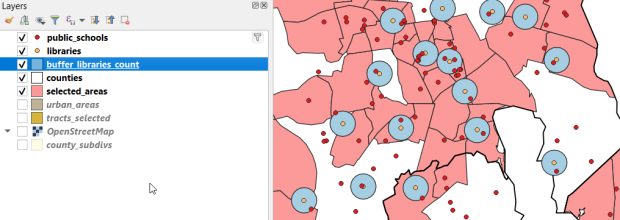I just released a new edition of my introductory QGIS manual for QGIS 3.16 Hannover (the current long term release), and as always I’m providing it under Creative Commons for classroom use and self-directed learning. I’ve also updated my QGIS FAQs handout, which is useful for new folks as a quick reference. This material will eventually move to a Brown University website, but when that happens I’ll still hold on to my page and will link to the new spot. I’m also leaving the previous version of the tutorial written for QGIS 3.10 A Coruna up alongside it, but will pull that down when the fall semester begins.
The new edition has a new title. When I first wrote Introduction to GIS Using Open Source Software, free and open source (FOSS) GIS was a novelty in higher ed. QGIS was a lot simpler, and I had to pull in several different tools to accomplish basic tasks like CRS transformations and calculating natural breaks. Ten years later, many university libraries and labs with GIS services either reference or support QGIS, and the package is infinitely more robust. So a name change to simply Introduction to GIS with QGIS seemed overdue.
My move from Baruch CUNY to Brown prompted me to make several revisions in this version. The biggest change was swapping the NYC-based business site selection example with a Rhode Island-based public policy one in chapters 2 and 3. The goal of the new hypothetical example is to identify public libraries in RI that meet certain criteria that would qualify them to receive funding for after school programs for K-12 public school students (replacing the example of finding an optimal location for a new coffee shop in NYC). In rethinking the examples I endeavored to introduce the same core concepts: attribute table joins, plotting coordinates, and geoprocessing. In this version I do a better job of illustrating and differentiating between creating subsets of features by: selecting by attributes and location, filtering (a new addition), and deleting features. I also managed to add spatial joins and calculated fields to the mix.
Changes to chapter 4 (coordinate reference systems and thematic mapping) were modest; I swapped out the 2016 voter participation data with 2020 data. I slimmed down Chapter 5 on data sources and tutorials, but added an appendix that lists web mapping services that you can add as base maps. Some material was shuffled between chapters, and all in all I cut seven pages from the document to slim it down a bit.
As always, there were minor modifications to be made due to changes between software versions. There were two significant changes. First, QGIS no longer supports 32 bit operating systems for Windows; it’s 64 bit or nothing, but that seems to be fairly common these days. Second, the Windows installer file is much bigger (and thus slower to download), but it helps insure that all dependencies are there. Otherwise, the differences between 3.16 and 3.10 are not that great, at least for the basic material I cover. In the past there was occasionally a lack of consistency regarding basic features and terminology that you’d think would be well settled, but thankfully things are pretty stable this time around.
If you have any feedback or spot errors feel free to let me know. I imagine I’ll be treading this ground again after the next long term release take’s 3.16’s place in Feb / Mar 2022. For the sake of stability I always stick with the long term release and forego the latest ones; if you’re going to use this tutorial I’d recommend downloading the LTR version and not the latest one.




